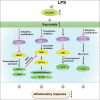The potential of using itaconate as treatment for inflammation-related heart diseases
- PMID: 35465278
- PMCID: PMC9020236
- DOI: 10.4103/tcmj.tcmj_83_21
The potential of using itaconate as treatment for inflammation-related heart diseases
Abstract
Intracellular metabolites can cause critical changes in biological functions. Itaconate is perhaps the most fascinating substance in macrophages. Lipopolysaccharide can activate aconitate decarboxylase 1 and induces the generation of itaconate from the tricarboxylic acid cycle by decarboxylation of cis-aconitate. It has been reported that itaconate has beneficial effects on inflammation and oxidation. The mechanisms involved in these effects include the suppression of succinate dehydrogenase, the activation of nuclear factor E2-related factor 2 by alkylation of Kelch-like ECH-associated protein 1, suppression of aerobic glycolysis through regulation of glyceraldehyde-3-phosphate dehydrogenase and fructose-bisphosphate aldolase A, and suppression of IκBζ translation through activating transcription factor 3 activation. All of these findings elucidated the possible therapeutic implications of itaconate in inflammation-related diseases. In this review, we highlight that itaconate is a crucial molecule of the immunomodulatory response in macrophages and can regulate between immune response and cardiovascular metabolism. Furthermore, these discoveries suggest that itaconate is a very novel therapeutic molecule for the treatment of inflammation-related heart diseases.
Keywords: Activating transcription factor 3; Inflammation; Itaconate; Nuclear factor erythroid 2-related factor 2; Succinate dehydrogenase.
Copyright: © 2021 Tzu Chi Medical Journal.
Conflict of interest statement
Dr. Ching-Feng Cheng, an editorial board member at Tzu Chi Medical Journal, had no role in the peer review process of or decision to publish this article. The other authors declared no conflicts of interest in writing this paper.
Figures



References
-
- Ferreira LM, Li AM, Serafim TL, Sobral MC, Alpoim MC, Urbano AM. Intermediary metabolism: An intricate network at the crossroads of cell fate and function. Biochim Biophys Acta Mol Basis Dis. 2020;1866:165887. - PubMed
-
- Moraru A, Wiederstein J, Pfaff D, Fleming T, Miller AK, Nawroth P, et al. Elevated levels of the reactive metabolite methylglyoxal recapitulate progression of type 2 diabetes. Cell Metab. 2018;27:926–34. e8. - PubMed
Publication types
LinkOut - more resources
Full Text Sources
Research Materials
